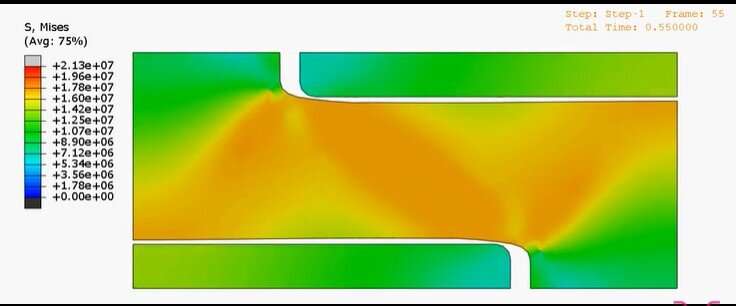Bioinspired protein creates stretchable 2D layered materials

Nature creates layered materials like bone and mother-of-pearl that become less sensitive to defects as they grow. Now researchers have created, using biomimetic proteins patterned on squid ring teeth, composite layered 2D materials that are resistant to breaking and extremely stretchable.
"Researchers rarely reported this interface property for the bone and nacre because it was difficult to measure experimentally," said Melik Demirel, Lloyd and Dorothy Foehr Huck Chair in Biomimetic Materials and director of the Center for Advanced Fiber Technologies, Penn State.
Composite 2D materials are made up of atom-thick layers of a hard material, like graphene or a MXene—usually a transition metal carbide, nitride or carbonitride—separated by layers of something to glue the layers together. While large chunks of graphene or MXenes have bulk properties, 2D composites' strength comes from interfacial properties.
"Because we are using an interfacial material that we can modify by repeating sequences, we can fine tune the properties," said Demirel. "We can make it very flexible and very strong at the same time."
He noted that the materials can also have unique thermal conduction regimes, or properties, spreading heat in one direction more strongly than at 90 degrees. The results of this work were published today (July 25th) in the Proceedings of the National Academy of Sciences.
"This material would be great for insoles for running shoes," said Demirel. "It could cool the foot and the repeated flexing would not break the insole."
These 2D composites could be used for flexible circuit boards, wearable devices and other equipment that requires strength and flexibility.
According to Demirel, traditional continuum theory does not explain why these materials are both strong and flexible, but simulations demonstrated that the interface matters. What apparently happens is that with a higher percent of the material composed of the interface, the interface breaks in places when the material is under stress, but the material as a whole does not break.
"The interface breaks, but the material doesn't," said Demirel. "We expected them to become compliant, but all of a sudden it is not only compliant, but super stretchy."
Others working on this project form Penn State were Mert Vural, postdoctoral fellow; Tarek Mazeed, postdoctoral fellow; Oguzhan Colak, graduate student; and Reginald F. Hamilton, associate professor all in Engineering Science and Mechanics.
Also working on this research were Dong Li, and Huajian Gao, professor of mechanical and aerospace engineering, both at Nanyang Technological University, Singapore.
More information: Bioinspired stretchable molecular composites of 2D-layered materials and tandem repeat proteins, Proceedings of the National Academy of Sciences (2022). DOI: 10.1073/pnas.2120021119.
Journal information: Proceedings of the National Academy of Sciences
Provided by Pennsylvania State University





















